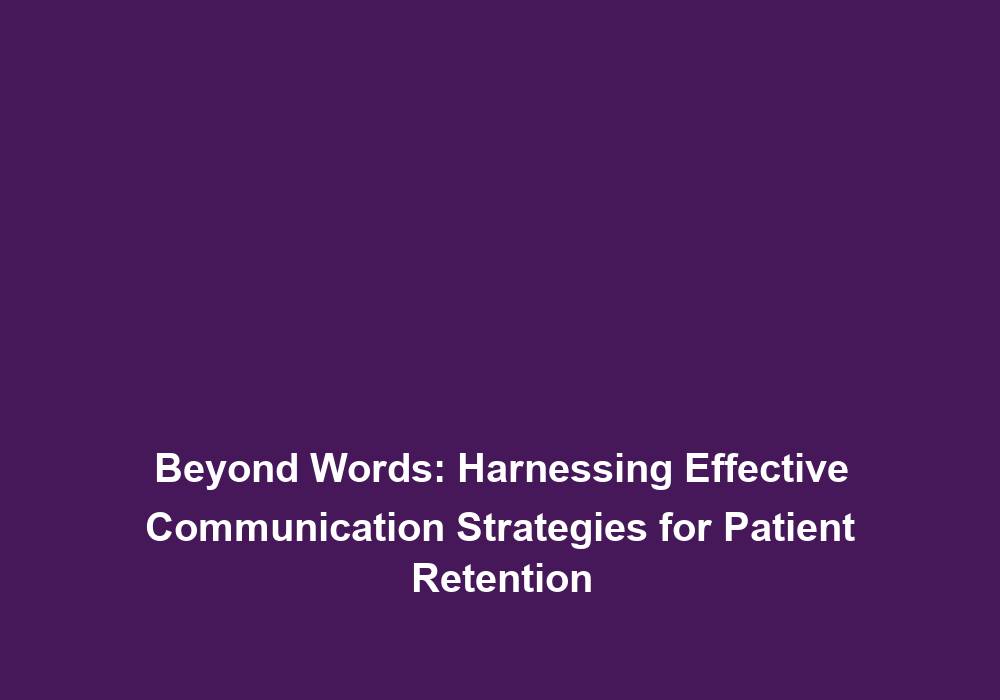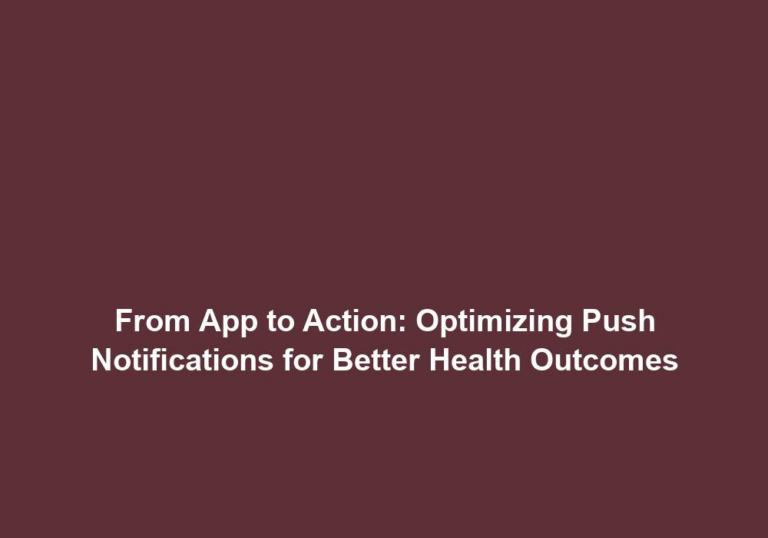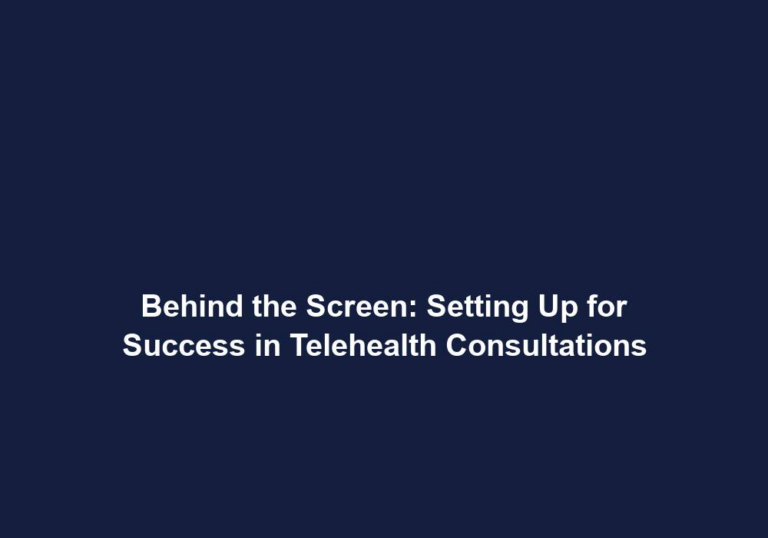Beyond Words: Harnessing Effective Communication Strategies for Patient Retention
Effective communication plays a crucial role in the success of any healthcare organization. It serves as the cornerstone for building strong relationships with patients and promoting patient retention. In today’s fast-paced world, where patients have more choices than ever before, healthcare providers must go beyond words to develop a comprehensive communication strategy that not only meets patients’ needs but exceeds their expectations. This article delves into the importance of effective communication in patient retention and provides valuable insights into how healthcare providers can harness this strategy to cultivate long-term patient loyalty.
The Power of Effective Communication in Patient Retention
-
Establishing Trust and Building Relationships:
Effective communication fosters trust between healthcare providers and patients. By actively listening to patients’ concerns and providing empathetic responses, healthcare providers create an environment where patients feel comfortable expressing their concerns and sharing sensitive information. This trust is crucial in cultivating long-term patient loyalty. Patients who trust their healthcare providers are more likely to remain loyal and seek care from the same provider, leading to improved patient retention rates.
Some ways to establish trust include:
- Building rapport: Taking the time to understand patients’ individual needs, preferences, and backgrounds can help create a connection and build trust.
- Being transparent: Openly sharing information about treatment options, risks, and benefits can help patients make informed decisions and feel more confident in their healthcare provider’s expertise.
- Consistency in care: Providing consistent and reliable care can reinforce patients’ trust in their healthcare provider and instill a sense of confidence in their treatment plan.
-
Enhancing Patient Satisfaction:
Communication is at the core of patient satisfaction. Clear and empathetic communication helps patients understand their health conditions, treatment options, and overall care process. When patients feel well-informed and supported, they are more likely to be satisfied with their healthcare experience and continue seeking care from the same provider.
Here are some ways to enhance patient satisfaction through effective communication:
- Providing personalized information: Tailoring communication to each patient’s unique needs and preferences can help them feel valued and engaged in their care.
- Addressing concerns promptly: Responding to patient inquiries and concerns in a timely manner shows that their needs are a priority and can help alleviate any anxiety or uncertainty they may have.
- Communicating with empathy: Demonstrating empathy and understanding towards patients’ emotions and experiences can foster a positive patient-provider relationship and contribute to overall satisfaction.
-
Encouraging Compliance and Adherence:
Effective communication promotes patient compliance and adherence to treatment plans. When healthcare providers clearly explain the importance of following prescribed medications, lifestyle changes, and recommended follow-up appointments, patients are more likely to adhere to their treatment regimen. Improved compliance leads to better health outcomes and higher patient retention rates.
Strategies to encourage compliance and adherence include:
- Providing clear instructions: Using simple and understandable language, healthcare providers can ensure that patients understand the treatment plan and how to follow it correctly.
- Emphasizing benefits: Explaining the potential benefits of adhering to the treatment plan can motivate patients to prioritize their health and stick to the prescribed regimen.
- Collaborative goal-setting: Involving patients in setting achievable goals and milestones can empower them to take an active role in their own care, increasing their commitment to the treatment plan.
-
Managing Expectations:
Communication is essential in managing patient expectations regarding treatment outcomes, recovery timelines, and potential side effects. By setting realistic expectations and addressing any concerns or misconceptions, healthcare providers can prevent dissatisfaction or premature discontinuation of care. Patients who have realistic expectations are more likely to stay engaged in their healthcare journey.
Strategies for managing patient expectations include:
- Providing accurate information: Offering clear and accurate information about the anticipated results and potential challenges of the treatment can help patients have realistic expectations.
- Offering alternatives: Presenting alternative treatment options and discussing their potential outcomes can give patients a sense of control and help manage their expectations.
- Regular progress updates: Keeping patients informed about their progress and any changes in the treatment plan can help them stay engaged and reassured about the effectiveness of their care.
Strategies for Effective Communication
-
Active Listening:
Active listening involves giving full attention to the patient and demonstrating empathy. Healthcare providers should be attentive to patients’ verbal and non-verbal cues, such as body language and emotions. By actively listening, healthcare providers can understand patients’ concerns, fears, and preferences, leading to more effective communication and patient-centric care.
Techniques for active listening:
- Maintaining eye contact: Making eye contact with the patient shows that their words are being heard and respected.
- Paraphrasing and summarizing: Restating what the patient has said in your own words helps ensure understanding and shows that you are actively engaged in the conversation.
- Asking open-ended questions: Encouraging patients to share more about their experiences and concerns can provide valuable insights and help build a stronger patient-provider relationship.
-
Clear and Simple Language:
Avoid using complex medical jargon that may confuse or intimidate patients. Healthcare providers should strive to use simple and understandable language to explain medical conditions, treatment options, and instructions. Visual aids, such as diagrams or illustrations, can enhance understanding and facilitate effective communication.
Tips for using clear and simple language:
- Use everyday language: Replace medical terminology with layman’s terms that patients can easily understand.
- Break down complex information: Present information in a step-by-step manner to ensure comprehension and avoid overwhelming patients with too much information at once.
- Use visual aids: Supplement verbal explanations with visual aids, such as diagrams or charts, to help patients visualize concepts and improve understanding.
-
Two-Way Communication:
Encourage patients to actively participate in their healthcare journey by inviting questions, concerns, and feedback. A two-way communication approach empowers patients and makes them feel valued and heard. Healthcare providers should create an open and non-judgmental environment that encourages patients to voice their thoughts and concerns.
Ways to promote two-way communication:
- Ask open-ended questions: Instead of asking yes/no questions, ask questions that encourage patients to share their thoughts and feelings more elaborately.
- Active engagement: Show genuine interest in what the patient has to say and respond empathetically to their concerns or questions.
- Feedback loops: Regularly seek feedback from patients about their experiences and use that feedback to improve communication and care processes.
-
Utilizing Technology:
Technology can greatly enhance communication between healthcare providers and patients. Secure messaging platforms, telehealth services, and patient portals enable timely and convenient communication, especially for non-urgent matters. Healthcare organizations should leverage technology to facilitate communication and provide personalized care experiences.
Examples of technology utilization in communication:
- Secure messaging platforms: Allow patients to communicate with their healthcare providers and ask non-urgent questions conveniently.
- Telehealth services: Enable virtual consultations and follow-up appointments, reducing the need for in-person visits and improving accessibility for patients.
- Patient portals: Provide patients with access to their medical records, test results, and educational resources, fostering engagement and facilitating communication.
-
Cultural Sensitivity:
Cultural competence is vital in effective communication. Healthcare providers should be aware of cultural differences, beliefs, and practices that may impact communication. By respecting and considering patients’ cultural backgrounds, healthcare providers can establish trust, avoid misunderstandings, and deliver tailored care.
Tips for cultural sensitivity in communication:
- Educate yourself: Seek knowledge about different cultures, customs, and beliefs to better understand and respect diverse patient populations.
- Avoid assumptions: Don’t make assumptions based on stereotypes or generalizations. Instead, approach each patient with an open mind and a willingness to learn about their unique cultural perspectives.
- Adapt communication styles: Take into account cultural norms that may influence communication preferences, such as directness or indirectness, to ensure effective and respectful interactions.
Conclusion
Effective communication is the backbone of patient retention in the healthcare industry. By investing in a comprehensive communication strategy, healthcare providers can build trust, enhance patient satisfaction, encourage compliance, and manage patient expectations. Active listening, clear language, two-way communication, technology utilization, and cultural sensitivity are key elements of a successful communication strategy. By prioritizing effective communication, healthcare organizations can foster long-term patient loyalty, leading to improved outcomes, patient satisfaction, and overall success.







